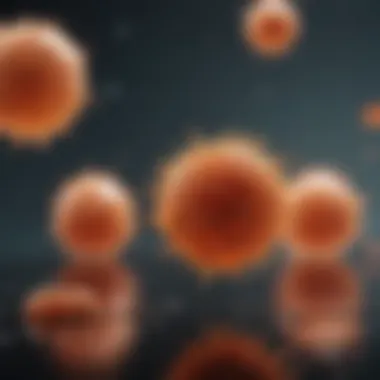Comprehensive Approaches to Chronic Leukemia Treatment


Article Overview
Purpose of the Article
Chronic leukemia represents a significant challenge in oncology due to its complex nature and the diversity in patient responses to treatment. The purpose of this article is to provide an extensive examination of the various approaches to managing chronic leukemia. This includes established treatment modalities, new and emerging therapies, and supportive care options. By presenting these methods in a comprehensive manner, the article aims to equip healthcare professionals, researchers, and students with insights that can enhance patient care.
Relevance to Multiple Disciplines
The topic of chronic leukemia intersects various fields including oncology, hematology, pharmacology, and patient care. Understanding the treatment options available is critical not only for oncologists and hematologists but also for primary care physicians and nurses who manage patients with chronic leukemia. Additionally, researchers will find value in the examination of ongoing studies and innovations that pave the way for future treatments. Thus, this article is relevant across multiple disciplines, fostering interdisciplinary collaboration in tackling the disease.
Research Background
Historical Context
Chronic leukemia, particularly chronic lymphocytic leukemia (CLL) and chronic myeloid leukemia (CML), has evolved significantly in terms of treatment and management since its initial descriptions. Historically, the prognosis for individuals diagnosed with chronic leukemia was poor, with limited therapeutic options. However, with the advent of chemotherapy in the mid-20th century, along with the discovery of targeted therapies like imatinib for CML, there has been a notable transformation in survival rates.
Key Concepts and Definitions
To better understand chronic leukemia treatment, it is essential to grasp some fundamental concepts:
- Chronic Leukemia: A slow-growing blood cancer where the body produces a large number of abnormal white blood cells.
- Chemotherapy: A type of cancer treatment that uses drugs to destroy cancer cells or stop their division.
- Targeted Therapy: A treatment that targets specific genes or proteins involved in cancer growth.
- Immunotherapy: A therapy that uses the body's immune system to fight cancer cells.
- Stem Cell Transplantation: A procedure to replace diseased or damaged bone marrow with healthy stem cells.
Each of these definitions serves as a foundation for understanding the various treatment strategies that will be discussed later in the article. By recognizing these concepts, readers can better appreciate the depth and complexity involved in managing chronic leukemia effectively.
Understanding Chronic Leukemia
Chronic leukemia represents a distinct category of blood cancer characterized by the slow buildup of abnormal blood cells. Understanding this form of leukemia is crucial for several reasons. First, knowledge of chronic leukemia aids in effective patient management. It forms the foundation needed to discuss the various treatment approaches suitable for different individuals based on their unique medical circumstances. Second, better comprehension allows both patients and healthcare professionals to engage in informed discussions about potential outcomes. The differences between types of chronic leukemia can significantly influence therapeutic choices.
In this article, we will explore not only the basic definitions but also the types of chronic leukemia, such as Chronic Lymphocytic Leukemia (CLL) and Chronic Myeloid Leukemia (CML). This exploration will touch upon their characteristics and how these can guide treatment options. We will also examine the importance of epidemiology and risk factors associated with hemorrhagic conditions, as an understanding of these elements can affect both prevention and management strategies in chronic leukemia.
Defining Chronic Leukemia
Chronic leukemia is defined as a condition where the body produces an excessive number of dysfunctional blood cells. Unlike acute leukemia, which develops rapidly, chronic leukemia progresses more slowly, allowing cells to accumulate over time. This chronic nature often leads to multiple complications, making early diagnosis and management essential.
Recognition of chronic leukemia involves various clinical signs and symptoms, including fatigue, unintentional weight loss, and frequent infections. Thus, understanding this definition sets the stage for deeper exploration into its various forms and implications for treatment.
Types of Chronic Leukemia
Chronic Lymphocytic Leukemia ()
Chronic Lymphocytic Leukemia is primarily characterized by the accumulation of immature lymphocytes in the blood, bone marrow, and lymph nodes. CLL is notable for its often indolent course, leading to a gradual decline in immune function. It is a popular topic in this article due to its prevalence among older adults. The gradual progress of CLL can also lead to less aggressive treatment approaches, which can be appealing for patients seeking to minimize treatment intensity.
A unique feature of CLL is its responsiveness to targeted therapies, which can significantly improve patient outcomes. Advantages of CLL treatments include the effective management of symptoms and disease stability over longer periods. Possible disadvantages might include the risk of developing secondary cancers due to prolonged exposure to therapies.
Chronic Myeloid Leukemia ()
Chronic Myeloid Leukemia arises from the proliferation of myeloid cells in the bone marrow and is particularly linked to the Philadelphia chromosome. This genetic abnormality is a hallmark of CML and allows for targeted treatments that can efficiently reduce the disease burden. CML is recognized in this article for its unique pathophysiology and treatment pathways.
A key characteristic of CML is its three-phase progression: chronic, accelerated, and blast crisis. Treatment has become a more structured approach with the advent of Tyrosine Kinase Inhibitors, which can lead to remarkably effective disease control. One disadvantage of CML could be the challenge of monitoring resistance to therapy as the disease progresses.
Other Rare Forms
Other unusual forms of chronic leukemia include atypical variants such as Chronic Monocytic Leukemia (CMML) and Hairy Cell Leukemia. These types, while less prevalent, entail unique diagnostic criteria and can significantly affect treatment choices. Their inclusion in this article emphasizes the importance of recognizing less common presentations of chronic leukemia.
These rare forms can sometimes require more specialized treatment algorithms, which may not be widely accessible. Thus, detailing these options is critical for comprehensive patient management. Knowledge of these rare forms provides valuable insights into broader diagnostic and therapeutic strategies.
Epidemiology and Risk Factors
Epidemiology focuses on the distribution and determinants of chronic leukemia in populations. Various factors influence the likelihood of developing chronic leukemia, including genetic predispositions, environmental exposures, and age. For instance, older males tend to have higher rates of CLL and CML, indicating a need for focused screening in these demographics. Understanding these risk factors supports healthcare practitioners in identifying at-risk patient populations, leading to early detection and better outcomes in management.
Initial Diagnosis and Evaluation
The process of initial diagnosis and evaluation in chronic leukemia plays a crucial role in determining the appropriate treatment plan. Accurate diagnosis is essential not only for confirming the presence of the disease but also for understanding its particular characteristics. This information guides healthcare professionals in designing individualized treatment strategies that are aligned with the patient's clinical profile, disease subtype, and overall health status. The early identification of chronic leukemia allows for timely intervention, which can significantly improve patient outcomes and quality of life.
Effective evaluation methods rely on a variety of diagnostic tests. These tests are pivotal in revealing the extent of disease and informing subsequent treatment decisions. Each test serves a unique function and collectively provides a comprehensive picture of the patient's condition.
Diagnostic Tests
Complete Blood Count (CBC)
The Complete Blood Count (CBC) is one of the primary tests conducted during the diagnostic process. It assesses several components in the blood, including red and white blood cells, hemoglobin levels, and platelets. One key characteristic of the CBC is its ability to indicate the presence of leukemic cells by comparing the counts of blood cells against normal ranges. This makes CBC a beneficial choice for diagnosing chronic leukemia as it can promptly reveal atypical levels which suggest underlying malignancies.
A notable advantage of the CBC is its minimal invasiveness and quick turnaround time for results. However, it is important to emphasize that CBC alone cannot confirm leukemia; it should be paired with further confirmatory tests.
Bone Marrow Biopsy
The Bone Marrow Biopsy involves taking a sample of bone marrow, usually from the hip bone. This procedure helps to pinpoint the exact type of leukemia through direct observation of the marrow. By detecting leukemic cells and evaluating their proportion, healthcare providers can better understand the disease's behavior and progression.
This test's unique feature lies in its ability to provide detailed information about the cellular composition of the marrow. It's often considered a critical step in the diagnostic process, making it a popular method among clinicians dealing with leukemia.
However, a disadvantage of bone marrow biopsy is the discomfort it may cause patients. Despite this, accurate diagnosis justifies the benefits, as it directly influences treatment options.


Cytogenetic Analysis
Cytogenetic Analysis examines the chromosomes within leukemia cells. This test helps identify specific genetic abnormalities associated with different types of chronic leukemia, such as the Philadelphia chromosome in Chronic Myeloid Leukemia (CML). These findings can be pivotal in determining prognosis and applicable treatment options.
One of the main attributes of cytogenetic analysis is its capacity to uncover molecular targets for targeted therapies, which are crucial for modern treatment approaches. Despite its high utility, this analysis can be time-consuming and may require a specialized laboratory for comprehensive results, making the wait frustrating for some patients.
Staging Approaches
The staging approaches used in diagnosing chronic leukemia are integral for understanding disease progression. Staging refers to determining how far the cancer has advanced, which influences treatment decisions and potential outcomes.
The commonly used staging system for chronic leukemias assesses various factors, including blood tests, bone marrow involvement, and the presence of symptoms. This strategic evaluation facilitates better communication among healthcare providers and establishes a clear pathway for patient management.
Conventional Treatment Options
Conventional treatment options for chronic leukemia are critical for managing this complex disease. These methods generally include chemotherapy, radiation therapy, and surgical interventions. Each approach comes with specific considerations that affect patient outcomes. Understanding these options is fundamental, as they provide structure to treatment pathways and help tailor interventions to patient-specific needs.
Chemotherapy
Standard Chemotherapy Regimens
Standard chemotherapy regimens are foundational in treating chronic leukemia. These regimens typically involve a combination of drugs that target rapidly dividing cells. One key characteristic of these regimens is their ability to reduce leukemic cell populations effectively. This makes standard chemotherapy a popular choice among hematologists due to its proven effectiveness in inducing remission.
However, chemotherapy does not come without its own set of challenges. A significant concern is the potential for side effects such as nausea, fatigue, and immunosuppression. Advantageously, the unique feature of these regimens is that they can be adjusted based on patient response and tolerance. This adaptability is crucial for optimizing treatment efficacy and enhancing the quality of life.
Treatment Cycles and Dosage
The concept of treatment cycles and dosage in chemotherapy is integral to achieving successful outcomes. Each cycle refers to a period during which the medication is administered, followed by a recovery period to allow the body to recuperate. This cycle structure emphasizes a key characteristic of maximizing drug effects while minimizing toxicity.
The rational approach to setting dosages can foster a beneficial treatment experience. However, finding the right balance can be complex. A unique aspect of this regimen is that dosing may vary based on age, weight, and overall health. While higher dosages can be more effective, they also can increase the risk of adverse effects. This dual-edge nature highlights the importance of careful monitoring during the treatment.
Radiation Therapy
Radiation therapy serves as another pivotal component in conventional treatment options. Targeting specific areas, this approach uses high-energy particles to kill or slow down the growth of abnormal cells. It is particularly useful in localized cases where leukemia has spread to specific organs. The precision of radiation therapy is crucial. It minimizes damage to surrounding healthy tissue, making it a valuable option for select patients. However, the duration and side effects, such as skin irritation and fatigue, require careful patient assessment.
Surgical Interventions
Surgical interventions can play a crucial role, especially for symptomatic relief or when considering curative options.
Splenectomy
Splenectomy, the surgical removal of the spleen, addresses complications arising from chronic leukemia, such as splenomegaly or severe cytopenia. The operation can reduce symptoms and improve blood cell counts, thus contributing positively to the patient’s prognosis. A key characteristic of splenectomy is its potential to mitigate the complications associated with leukemic infiltration, offering a clear benefit in specific cases. However, the risks include infections and bleeding, warranting thorough patient selection and post-operative care.
Lymph Node Dissection
Lymph node dissection involves the removal of affected lymph nodes and aids in diagnosing the extent of leukemia spread. This procedure is advantageous because it allows for direct assessment of disease progress. It can provide valuable insights into individual pathology and helps physicians tailor further treatment plans. The primary downside lies in the potential for surgical complications, which must be weighed against the potential benefits.
In summary, conventional treatment options form the backbone of chronic leukemia management. The interplay between chemotherapy, radiation, and surgery lays a fundamental framework for optimal patient care. Each method carries its advantages and challenges, necessitating individualized treatment plans that consider patient characteristics and preferences.
"Effective treatment requires not only understanding the disease but also tailoring interventions to each patient's unique circumstances."
"Effective treatment requires not only understanding the disease but also tailoring interventions to each patient's unique circumstances."
Targeted Therapies in Chronic Leukemia
Targeted therapies have become increasingly important in the treatment of chronic leukemia. They offer a more precise approach compared to traditional methods, focusing on specific biological markers associated with cancer cells. This article discusses key elements, benefits, and considerations of targeted therapies in chronic leukemia management.
Overview of Targeted Therapies
Targeted therapies aim to interrupt cancer development through specific pathways, minimizing damage to normal cells. In chronic leukemia, these therapies can yield better outcomes while often reducing side effects. This level of precision allows clinicians to tailor treatments according to unique patient profiles and tumor characteristics.
Specific Agents and Mechanisms
Tyrosine Kinase Inhibitors (TKIs)
Tyrosine Kinase Inhibitors (TKIs) stand out as a critical advancement in chronic leukemia treatment. These agents, such as imatinib, specifically target the BCR-ABL fusion protein found in Chronic Myeloid Leukemia (CML). By blocking the signaling pathways that promote cell growth and division, TKIs hinder the progress of the disease effectively.
A significant characteristic of TKIs is their ability to suppress the malignant cells while sparing healthy tissue, which results in fewer side effects compared to standard chemotherapy. This feature makes TKIs a preferred choice in contemporary treatment paradigms.
However, resistance to TKIs can develop over time, which limits their long-term effectiveness. Patients may require alterations in their treatment plans. A careful monitoring strategy is necessary to address potential resistance.
Monoclonal Antibodies
Monoclonal antibodies are another powerful class of agents that play a role in chronic leukemia management. They function by binding to specific antigens on cancer cells, marking them for destruction by the immune system. Agents like rituximab are commonly used in Chronic Lymphocytic Leukemia (CLL).
The key characteristic of monoclonal antibodies lies in their specificity, which reduces the likelihood of collateral damage to normal cells, similar to TKIs. This leads to an improved safety profile, making them an attractive option for patients who may be frail or have significant comorbidities.
However, treatment can be expensive and patient access may vary. Adverse reactions, although generally manageable, can occur in a small subset of patients and must be carefully monitored.
"Targeted therapies offer a promising alternative to traditional approaches, enhancing the precision of chronic leukemia treatment while potentially improving patient quality of life."
"Targeted therapies offer a promising alternative to traditional approaches, enhancing the precision of chronic leukemia treatment while potentially improving patient quality of life."


In summary, targeted therapies represent a significant shift in the treatment landscape of chronic leukemia. As research continues, the integration of these agents in treatment protocols will likely evolve, emphasizing their role in personalized medicine.
Immunotherapy Approaches
Immunotherapy has emerged as a significant advancement in the treatment of chronic leukemia. This approach utilizes the body's immune system to target and eliminate cancer cells. As traditional treatments like chemotherapy and radiation therapy can have severe side effects, immunotherapy offers a unique benefit. It can often provide a more targeted attack on malignant cells while sparing healthy tissue. The relevance of immunotherapy in leukemia treatment cannot be overstated, as it introduces new dynamics into the oncological treatment landscape.
Mechanisms of Action
Immunotherapy works through different mechanisms to combat cancer. One primary method involves enhancing the immune system's ability to detect and destroy cancer cells. This can be achieved through various strategies, including:
- Stimulating immune responses: Some therapies boost overall immune system activity, increasing the number of immune cells available to fight leukemia.
- Targeting specific proteins: Other therapies may focus on disruptin the signals that allow cancer cells to hide from the immune system.
- Engaging immune cells directly: Certain drugs can activate specific immune cells, leading them to target leukemia more effectively.
These distinct strategies help immunotherapy become an integral part of managing chronic leukemia, especially for patients who do not respond well to conventional treatments.
Immune Checkpoint Inhibitors
Immune checkpoint inhibitors are a subset of immunotherapy that has gained attention in recent years. These agents work by blocking checkpoint proteins from binding with their partner proteins. This process prevents the shutdown of immune responses, allowing T-cells to attack cancer cells more aggressively.
Key checkpoints involved include:
- Programmed cell death protein 1 (PD-1): This checkpoint can be utilized by cancer cells to evade the immune response.
- Cytotoxic T-lymphocyte-associated protein 4 (CTLA-4): This checkpoint regulates immune responses and can inhibit T-cell activity.
Using checkpoint inhibitors in chronic leukemia has shown promise in clinical trials, leading to improved survival rates and reduced disease progression. However, it is important to consider potential side effects, which may include autoimmune reactions. Screening for patient suitability is a critical component of the treatment process.
In summary, immunotherapy represents a significant shift in treating chronic leukemia by utilizing the body's own defenses. With its mechanisms of action, particularly through immune checkpoint inhibitors, it paves the way for more personalized treatment options. Future research will likely continue to unveil further improvements and alternatives within this field.
In summary, immunotherapy represents a significant shift in treating chronic leukemia by utilizing the body's own defenses. With its mechanisms of action, particularly through immune checkpoint inhibitors, it paves the way for more personalized treatment options. Future research will likely continue to unveil further improvements and alternatives within this field.
Stem Cell Transplantation
Stem cell transplantation is a crucial treatment option for patients with chronic leukemia, particularly when conventional therapies have not provided sufficient results. This procedure involves replacing damaged or diseased bone marrow with healthy stem cells, facilitating the production of new, healthy blood cells. The importance of stem cell transplantation lies in its potential to cure certain types of chronic leukemia, offering hope for remission in cases where other treatments have failed. Understanding the specific types of stem cell transplants is key to optimizing outcomes.
Types of Stem Cell Transplants
Autologous Transplant
An autologous transplant entails the use of a patient’s own stem cells. The process begins by collecting stem cells from the patient before undergoing high-dose chemotherapy. These harvested cells are then stored and reinfused into the patient’s body after the treatment.
The key characteristic of autologous transplants is their ability to reduce the risk of rejection since the cells come from the patient. This option is often favored in cases where the patient is in good health and has a sufficient number of viable stem cells.
Advantages of this approach include a lower risk of complications associated with graft-versus-host disease, which is a serious condition that can arise when donor cells attack the recipient’s body. However, disadvantages can include the possibility that the leukemia will relapse, as the reinfused cells may carry leukemic cells.
Allogeneic Transplant
Allogeneic transplant involves using stem cells from a donor, which could be a relative or an unrelated individual. This form of transplant is often considered for patients whose disease is more aggressive or who have relapsed after other treatments.
The key characteristic of allogeneic transplants is the potential for a more robust immune response against leukemic cells due to the presence of donor immune cells. This is often why it is seen as a beneficial choice for high-risk patients looking for a more aggressive treatment strategy.
Advantages of allogeneic transplantation include the heightened chance of complete remission, as the donor cells can actively target and eliminate any remaining cancerous cells in the patient. Conversely, the disadvantages include a higher risk of graft-versus-host disease and other complications resulting from the donor's immune cells attacking the recipient's body.
Eligibility Criteria and Outcomes
Eligibility for stem cell transplantation varies based on several factors, including the type of leukemia, overall health, and age of the patient. Generally, younger patients with fewer underlying health issues tend to have better outcomes. The degree of remission prior to transplantation is also a significant consideration.
In terms of outcomes, autologous transplants generally provide good results for specific types of chronic leukemia, while allogeneic transplants can lead to higher survival rates in patients with more aggressive forms. Long-term follow-up is essential to monitor for possible complications and evaluate the patient’s recovery journey.
"Stem cell transplantation stands at the intersection of hope and scientific advancement, marking a pivotal turning point for many chronic leukemia patients."
"Stem cell transplantation stands at the intersection of hope and scientific advancement, marking a pivotal turning point for many chronic leukemia patients."
Supportive Care in Chronic Leukemia Management
Supportive care plays a crucial role in the management of chronic leukemia. While primary treatments target the cancer itself, supportive care improves overall quality of life and addresses symptoms and side effects that arise during treatment. This aspect of care is not merely supplementary; it is essential in ensuring that patients can tolerate and respond to their treatments effectively.
Key elements of supportive care include pain management, nutritional support, psychological counseling, and the management of treatment-related side effects. These components help in mitigating discomfort, providing emotional support, and optimizing nutritional intake, which are all vital in bolstering the body's capacity to fight the disease. The importance of integrating supportive care into treatment plans cannot be overstated, especially in complex cases of chronic leukemia where patients might experience a range of symptoms that interfere with their daily lives.
Managing Side Effects of Treatment
Managing side effects is a critical focus of supportive care in chronic leukemia management. Treatments such as chemotherapy and targeted therapies are commonly associated with a variety of adverse effects. Some of the frequent side effects include nausea, fatigue, hair loss, and increased susceptibility to infections.
By addressing these side effects effectively, healthcare providers can enhance patient adherence to treatment plans and improve overall satisfaction with care. Here are some strategies employed to manage these side effects:
- Pharmacological Interventions: Medications such as anti-nausea drugs help control symptoms like vomiting associated with chemotherapy.
- Nutritional Guidance: Registered dietitians assist patients in maintaining proper nutrition, which is essential for recovery and energy levels.
- Physical Therapy: Gentle exercises can help combat fatigue and promote general well-being.
- Emotional Support: Providing access to counseling helps patients deal with the psychological strains of their condition.
Overall, proactive management of treatment side effects ensures that patients can continue their therapies with minimal disruption and a better quality of life.
Palliative Care Strategies
Palliative care is another vital component in the holistic management of chronic leukemia. It focuses on alleviating suffering and improving the quality of life for patients facing serious illnesses, including those experiencing advanced stages of leukemia. Palliative care is not limited to end-of-life scenarios but can be integrated at any stage of treatment.
Key strategies in palliative care for chronic leukemia include:


- Symptom Control: This involves alleviating pain, managing fatigue, and addressing psychological distress, often through a combination of medications and therapeutic approaches.
- Holistic Assessments: Evaluating the physical, emotional, and social needs of the patient leads to more tailored and effective intervention plans.
- Family Assistance: Palliative care extends support to family members, providing them with guidance and respite as they navigate the complexities of chronic illness.
- Advanced Care Planning: This important aspect helps patients articulate their wishes regarding future medical interventions and end-of-life care, ensuring that their preferences are respected.
Palliative care is focused on improving the overall quality of life, emphasizing comfort and dignity for patients with chronic leukemia at any stage.
Palliative care is focused on improving the overall quality of life, emphasizing comfort and dignity for patients with chronic leukemia at any stage.
In summary, supportive care, inclusive of managing side effects and implementing palliative care strategies, is integral to the treatment of chronic leukemia. This comprehensive approach not only enhances the effectiveness of primary treatments but also addresses the multifaceted needs of the patient, creating a more favorable treatment journey.
Emerging Treatment Insights
The landscape of chronic leukemia treatment is continuously evolving. Emerging treatment insights play a critical role in enhancing patient outcomes through innovative therapies and research advancements. These insights provide a glimpse into the future of chronic leukemia management. Understanding these advancements is essential for students, researchers, and healthcare professionals.
Advances in Research
Current research in chronic leukemia aims to improve the effectiveness and safety of treatment options. Several areas of focus include:
- Genomic Profiling: This allows clinicians to understand the specific genetic mutations present in each patient's leukemia. This information helps tailor therapy to more precisely target cancer cells.
- Novel Targeting Strategies: Researchers explore new ways to inhibit cancer cell growth. For example, investigatins into combination therapies can minimize resistance to existing treatments.
- Biomarkers: Identifying biomarkers aids in predicting treatment response. Biomarkers can forecast how well a patient might respond to certain therapies, leading to more personalized treatment plans.
These advancements aim not only to improve survival rates but also to enhance the quality of life for patients. Engaging with recent findings is vital for staying abreast of significant developments.
Clinical Trials and Novel Therapies
Clinical trials are the backbone of innovation in leukemia treatment. They test new therapies and can provide patients access to cutting-edge treatments long before they are widely available. Key points regarding clinical trials and novel therapies include:
- Phases of Trials: Clinical trials occur in phases I, II, and III, each designed to assess safety and efficacy. Early-phase trials focus on safety, while later phases evaluate effectiveness in larger populations.
- New Drug Approvals: Recent trials have led to the approval of new medications, such as Venetoclax and Nivolumab, for certain patient populations. These drugs specifically target unique characteristics of chronic leukemia cells and affect cell signaling pathways.
- Combination Therapies: Many trials assess combinations of existing drugs with newer agents. This approach may minimize drug resistance or improve overall responses.
Participating in clinical trials offers patients valuable options and helps advance medical knowledge regarding chronic leukemia.
"The expansion of knowledge through research is key to transforming chronic leukemia treatment into a more personalized and effective journey for patients."
"The expansion of knowledge through research is key to transforming chronic leukemia treatment into a more personalized and effective journey for patients."
The information on emerging treatment insights showcases the importance of ongoing research and clinical trials. By integrating these advancements into treatment plans, healthcare providers can offer more effective, personalized therapies for those diagnosed with chronic leukemia.
Patient-Centric Approaches
In the context of chronic leukemia treatment, patient-centric approaches are essential for achieving optimal care outcomes. These strategies place the patient at the core of the treatment process, emphasizing individual needs, preferences, and values. By focusing on the patient's perspective, healthcare providers can enhance engagement and improve adherence to treatment plans. This approach acknowledges that each individual’s experience with chronic leukemia can differ significantly, influenced by factors such as genetics, lifestyle, and psychosocial aspects.
Informed Decision Making
Informed decision making is a cornerstone of patient-centric care. This process involves providing patients with comprehensive information about their diagnosis, treatment options, and potential outcomes. A well-informed patient can better understand their illness and the implications of various treatment strategies.
- Communication: Clear and open communication between medical professionals and patients fosters trust. Patients should feel comfortable asking questions and expressing their concerns.
- Choosing Treatment: Patients should actively participate in discussions about which therapies they prefer. Whether it is chemotherapy, targeted therapy, or immunotherapy, preferences should be weighed along with medical recommendations.
- Understanding Risks and Benefits: It is crucial for patients to grasp the potential risks and benefits associated with each treatment option. This understanding aids in aligning treatment choices with personal values and life goals.
Ultimately, informed decision making encourages shared responsibility between healthcare providers and patients, leading to more tailored and effective treatment outcomes.
Psychosocial Considerations
Psychosocial considerations play a vital role in the treatment of chronic leukemia, as the emotional and mental well-being of patients significantly influences their ability to cope with the disease.
- Mental Health Support: Patients may experience anxiety, depression, or fear related to their diagnosis. Providing access to mental health resources can help them manage these feelings.
- Support Networks: Encouraging familial or community support can improve emotional resilience. Support groups allow patients to connect with others facing similar challenges, sharing experiences and coping strategies.
- Quality of Life: Focusing on quality of life is critical. Treatment should not only aim for remission but also consider side effects that may impact daily living. Care plans may include interventions aimed at enhancing comfort and mental well-being.
"Addressing psychosocial aspects is as important as the biological treatment of the disease. Empowering patients with mental and emotional support can transform their overall treatment experience."
"Addressing psychosocial aspects is as important as the biological treatment of the disease. Empowering patients with mental and emotional support can transform their overall treatment experience."
By incorporating these considerations into the treatment strategy, healthcare providers can help patients navigate the complexities of their illness while promoting a holistic approach that acknowledges both physical and mental health.
Future Perspectives in Chronic Leukemia Treatment
The exploration of future perspectives in chronic leukemia treatment is essential in shaping effective and innovative approaches to managing this disease. As the landscape of medicine evolves, understanding these perspectives allows healthcare professionals and patients alike to navigate the complexities of treatment options available today and in the near future.
The potential for advancements in therapeutic strategies ensures that patient outcomes continue to improve. With research moving rapidly in various directions, including genomics and novel drug development, personalized treatment plans that account for individual genetic makeup and disease characteristics may become standard. This section will delineate crucial elements such as personalized medicine developments and paradigm shifts in treatment methodologies.
Personalized Medicine Developments
Personalized medicine represents a significant advancement in the treatment of chronic leukemia, particularly through the application of genomics and other biomarkers. By tailoring treatment to the individual’s unique genetic profile, healthcare providers can more effectively target the underlying mechanisms of the disease.
Research shows that specific genetic mutations largely influence the effectiveness of particular therapies. For instance, chronic myeloid leukemia has demonstrated positive outcomes with targeted therapies like imatinib, effective mainly when specific genetic changes are present. This indicates the importance of comprehensive genetic testing before determining the treatment plan.
Moreover, as various genomic technologies evolve, the accuracy of identifying suitable targeted agents improves. This technology shift leads to early interventions and potentially better prognoses.
Other aspects of personalized medicine include:
- Genetic Sequencing: Identifying specific mutations that contribute to cancer progression can inform therapeutic choices.
- Biomarkers: Discovering new biomarkers can help in predicting treatment responses and adjustments.
- Pharmacogenomics: Understanding how genes affect a patient’s response to drugs enables clinicians to prescribe the most effective medications without unnecessary side effects.
Potential Paradigm Shifts
As the field of oncology progresses, we anticipate several paradigm shifts that could redefine chronic leukemia management. These shifts may arise from technological advancements and deeper insights into disease biology, leading to more strategic treatment approaches.
One notable potential shift is the integration of artificial intelligence and machine learning into treatment planning. By analyzing vast datasets, these technologies can identify patterns that human analysts might overlook, thereby recommending treatment strategies with higher success rates. This real-time analysis could significantly enhance the decision-making process for clinicians.
Furthermore, combination therapies are gaining prominence. Rather than relying solely on single-agent treatments, utilizing multiple modalities can enhance efficacy and reduce resistance mechanisms. For example, combining immunotherapy with targeted drugs can create a synergistic effect, offering improved outcomes.
Lastly, there is an increasing emphasis on patient involvement in treatment decisions. As patients become more educated and empowered, they often seek participatory roles in their care. This engagement can lead to tailored treatment choices that align with individual preferences and lifestyles.
The need for continuous adaptation in treatment strategies highlights the significance of understanding evolving perspectives in chronic leukemia management.
The need for continuous adaptation in treatment strategies highlights the significance of understanding evolving perspectives in chronic leukemia management.



